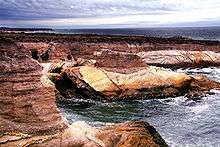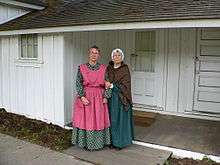Montaña de Oro State Park
| Montaña de Oro State Park | |
|---|---|
|
| |
  | |
| Location | San Luis Obispo County, California |
| Coordinates | 35°15′50.04″N 120°51′43.92″W / 35.2639000°N 120.8622000°WCoordinates: 35°15′50.04″N 120°51′43.92″W / 35.2639000°N 120.8622000°W |
| Area | 8,000 acres (32.4 km2) |
| Governing body | California Department of Parks and Recreation |
Montaña de Oro ("Mountain of Gold" in Spanish) is a state park in California, United States. The park is located six miles southwest of Morro Bay and 2 miles south of Los Osos. The name "Mountain of Gold" comes from the golden wildflowers found in the park.
It has 8,000 acres (32 km²) of cliffs, sandy beaches, coastal plains, streams, canyons, and hills, including the 1,347-foot (411 m) Valencia Peak. The park has many hiking, mountain biking, and equestrian trails, as well as a campground located across from Spooner’s Cove, a popular beach.
Proposed for closure
Los Osos Oaks State Reserve was one of the 48 California state parks proposed for closure in January 2008 by California's Governor Arnold Schwarzenegger as part of a deficit reduction program but will now stay open due to public outcry.[1]
16th-18th century Chumash Indians on California's central coast

Five hundred years ago, when Europeans first arrived on the California's central coast, they found it inhabited by the Chumash Indians. An estimated 20,000 to 30,000 of them lived in small villages spread over a territory which extended from Morro Bay south to Malibu. Although the Chumash depended heavily upon the sea, they also drew on many other sources for food, clothing, and shelter, and were probably part of a large trading network. The Spanish Explorers who visited the Montana de Oro area in 1542 recorded that the Indians were attractive, friendly people who paddled out to greet them in canoes.
In 1769, Don Gaspar de Portola marched his troops north from San Diego to establish new territory for the king of Spain. With the beginning of the Mission period, the Indians were moved inland, and this was the beginning of the end for the Chumash. Most died from European diseases to which they had no immunity. The survivors abandoned their villages and disappeared. With them, their customs, heritage and culture all but vanished as well. Traces of Chumash middens (refuse mounds) and village sites can still be seen in the park, but our knowledge of the Chumash culture remains sketchy. Archaeological advances and further research may help fill in the gaps. For this reason, and so that others may enjoy them, it is against the law to tamper with or disturb any Indian sites.
History after 1850

The property rights for Montaña de Oro State Park land area changed hands several times after California became a territory of the United States. It was used mostly for grazing sheep until 1892, when Alden B. Spooner, Jr., leased the land he later purchased around Islay Creek. He brought in dairy cattle, hogs and other agriculture. His two sons founded the Pecho Ranch & Stock Co., and built a ranch house, a complex of barns, a creamery, stables, sheds, and a waterwheel for power. On the south bluff of Spooner's Cove they utilized a warehouse with a long chute that led down to a wharf and a loading boom to service coastal steamers. The land just to the north was owned by Alexander S. Hazard, who also raised crops and maintained a dairy. Hoping to cash in on California's growing need for timber, he planted hundreds of eucalyptus trees, turning Hazard Canyon into a prospective lumber farm. Unfortunately, eucalyptus proved unsatisfactory for commercial use. In the early 1940s, a flood scoured Hazard Canyon, and in 1947 a grass fire burned up the coast from Diablo Canyon, destroying much of what had been the Hazard dairy buildings. However, Hazard's legacy, the rows of eucalyptus trees, remains. Rancher Oliver C. Field bought the land in the early 1940s, but sold it to Irene McAllister about ten years later. In 1965 the property was purchased by the State of California for a state park, and it was decided to keep the name McAllister had given it: "Montaña de Oro".[2]
On April 24, 1965, Rancho Montaña de Oro was dedicated as a California State Park after it was purchased out of the Rancho Montaña de Oro, Inc. bankruptcy proceeding under the Park acquisition program that then Governor Edmund G. "Pat" Brown had launched and managed to fund.
The Rancho Montaña de Oro property was held by Rancho Montaña de Oro, Inc., which was owned by Irene M. Starkey. California Beaches and Parks Director Charles De Turk convinced Morris J. Lavine, the attorney who was involved in the bankruptcy proceedings, to hold the property until the Parks Department could purchase it. Rancho Montaña de Oro, until recently, has had the longest uninterrupted, preserved and undeveloped coastal area of any publicly owned land in California.

Marine protected areas
Morro Bay State Marine Recreational Management Area and Morro Bay State Marine Reserve and Point Buchon State Marine Reserve and Marine Conservation Area are marine protected areas offshore from the Morro Bay area. Like underwater parks, these marine protected areas help conserve ocean wildlife and marine ecosystems.
References
External links
| Wikimedia Commons has media related to Montana de Oro State Park. |
- California State Parks: official Montaña de Oro State Park website
- Montana de Oro photo gallery, by a park docent